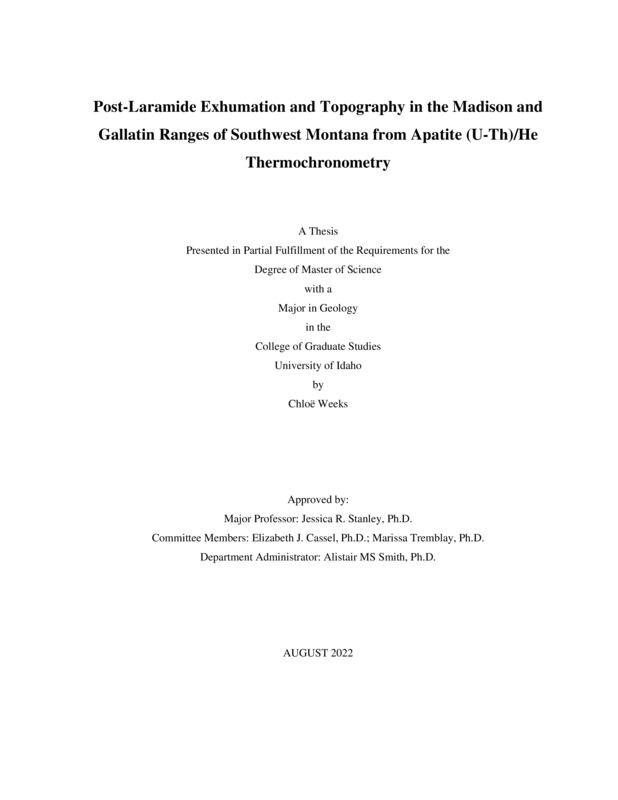Post-Laramide exhumation and topography in the Madison and Gallatin Ranges of southwest Montana from apatite (U-Th)/He thermochronometry
Weeks, Chloe. (2022-08). Post-Laramide exhumation and topography in the Madison and Gallatin Ranges of southwest Montana from apatite (U-Th)/He thermochronometry. Theses and Dissertations Collection, University of Idaho Library Digital Collections. https://www.lib.uidaho.edu/digital/etd/items/weeks_idaho_0089n_12459.html
- Title:
- Post-Laramide exhumation and topography in the Madison and Gallatin Ranges of southwest Montana from apatite (U-Th)/He thermochronometry
- Author:
- Weeks, Chloe
- ORCID:
- 0000-0001-8851-9349
- Date:
- 2022-08
- Keywords:
- (U-Th)/He thermochronometry landscape evolution southwest Montana tectonics yellowstone hotspot
- Program:
- Geography & Geological Science
- Subject Category:
- Geology
- Abstract:
-
Since the end of the Laramide Orogeny, southwest Montana has been subject to a complex array of tectonic, volcanic, and mantle dynamic processes that have left an imprint on the topography and landscape. Here, we aim to examine the impact of post-orogenic and more recent hotspot-related processes on the landscape by quantifying the Cenozoic exhumation history of the Madison and Gallatin Ranges, located on the northern flank of the Yellowstone hotspot in southwest Montana. We apply the apatite (U-Th)/He (AHe) low-temperature thermochronometer to Cretaceous and Tertiary intrusions found throughout the area to provide constraints on the Cenozoic cooling history. We acquired AHe dates from bedrock samples collected along two elevation transects and one horizontal transect to establish any differences in exhumation rates and magnitudes. AHe dates from 16 samples produced a range of dates from 70 ± 3.4 Ma to 6.4 ± 0.28 Ma. Samples of the largest elevation transect display a positive relationship between date and elevation suggesting they are undergoing continuous exhumation at either a constant or increasing relief during the Eocene through Oligocene. Increased topography and erosion during Eocene extension and eventual extensional collapse may have driven exhumation and cooling during this time, in addition to increased topography and erosion from the widespread magmatism of the Absaroka Volcanic Province. Changes to topography may be attributed to surface uplift, increasing relief, or a combination of the two. Signals of later cooling in samples close to the Madison Fault are inferred to predominantly record fault driven exhumation. Erosional exhumation due Yellowstone hotspot driven regional uplift appears to be minimal.
- Description:
- masters, M.S., Geography & Geological Science -- University of Idaho - College of Graduate Studies, 2022-08
- Major Professor:
- Stanley, Jessica R
- Committee:
- Cassel, Elizabeth J; Tremblay, Marissa; Smith, Alistair
- Defense Date:
- 2022-08
- Identifier:
- Weeks_idaho_0089N_12459
- Type:
- Text
- Format Original:
- Format:
- application/pdf
- Rights:
- In Copyright - Educational Use Permitted. For more information, please contact University of Idaho Library Special Collections and Archives Department at libspec@uidaho.edu.
- Standardized Rights:
- http://rightsstatements.org/vocab/InC-EDU/1.0/

